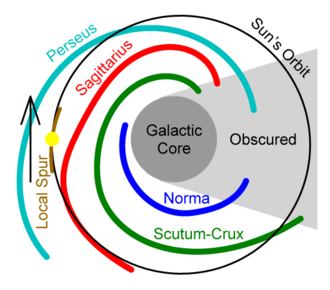
© The Daily Galaxy
Is there a genocidal countdown built into the motion of our solar system? Recent work at Cardiff University suggests that our system's orbit through the Milky Way encounters regular speedbumps - and by "speedbumps" we mean "potentially extinction-causing asteroids".
Professor William Napier and Dr Janaki Wickramasinghe completed computer simulations of the motion of the Sun in our outer spiral-arm location in the Milky Way that revealed a regular oscillation through the central galactic plane, where the surrounding dust clouds are the densest. The solar system is a non-trivial object, so its gravitational effects set off a far-reaching planetoid-pinball machine which often ends with comets being hurled into the intruding system.
The sun is about 26,000 light-years from the center of the Milky Way Galaxy, which is about 80,000 to 120,000 light-years across (and less than 7,000 light-years thick). We are located on on one of its spiral arms, out towards the edge. It takes the sun -and our solar system- roughly 200-250 million years to orbit once around the Milky Way. In this orbit, we are traveling at a velocity of about 155 miles/sec (250 km/sec).
Many of the ricocheted rocks collide with planets on their way through our system, including Earth. Impact craters recorded worldwide show correlations with the ~37 million year-cycle of these journeys through the galactic plane - including the vast impact craters thought to have put an end to the dinosaurs two cycles ago.
Almost exactly two cycles ago, in fact. The figures show that we're very close to another danger zone, when the odds of asteroid impact on Earth go up by a factor of ten. Ten times a tiny chance might not seem like much, but when "Risk of Extinction" is on the table that single order of magnitude can look much more imposing.

© E. Mercer (Boston Univ.), et al., SSC, JPL-Caltech, NASA, and the GLIMPSE Team
You have to remember that ten times a very small number is still a very small number - and Earth has been struck by thousands of asteroids without any exciting extinction events. A rock doesn't just have to hit us, it has to be large enough to survive the truly fearsome forces that cause most to burn up on re-entry.
Professors Medvedev and Melott of the University of Kansas have a different theory based on the same regular motion. As the Sun ventures out "above" the galactic plane, it becomes increasingly exposed to the cosmic ray generating shock front that the Milky Way creates as it ploughs through space. As we get closer to this point of maximum exposure, leaving the shielding of the thick galactic disk behind, the Kansas researchers hold that the increasing radiation destroys many higher species, forcing another evolutionary epoch. This theory also matches in time with the dinosaur extinction.
Either way, don't go letting your VISA bill run up just yet. "Very close" in astronomical terms is very, very different to "close" in
homo sapien time.
The characteristic spiral arms of the Milky Way regions where stars and gas are a little closer together -- waves of higher density than elsewhere in our galaxy's disc. Their additional gravity is normally too weak to alter a star's path by much, but if the star's orbital speed happens to match the speed at which the spiral arm is itself rotating, then the extra force has more time to take effect.
Simulations completed by Rok Roskar of the University of Zurich, Switzerland, show that a lucky star can ride the wave for 10,000 light years or more. Our sun is an example, with some measurements implying that the sun is richer in heavy elements than the average star in our neighbourhood, suggesting it was born in the busy central zone of the galaxy, where stellar winds and exploding stars enrich the cosmic brew more than in the galactic suburbs. The gravitational buffeting the solar system received then might also explain why Sedna, a large iceball in the extremities of the solar system, travels on a puzzling, enormously
elongated orbit.The cosmic panorama at top of page is courtesy of the Galactic Legacy Infrared Mid-Plane Survey Extraordinaire (GLIMPSE) project and the Spitzer Space Telescope. The galactic plane itself runs through the middle of the false-color view. Spitzer's infrared cameras see through much of the galaxy's obscuring dust revealing many new star clusters as well as star forming regions (bright white splotches) and hot interstellar hydrogen gas (greenish wisps). The pervasive red clouds are emission from dust and organic molecules, pocked with holes and bubbles blown by energetic outflows from massive stars. Intensely dark patches are regions of dust too dense for even Spitzer's infrared vision to penetrate.
Reader Comments
to our Newsletter